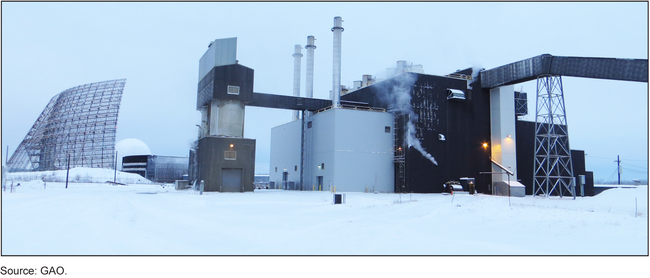Clear Air Force Station: Air Force Reviewed Costs and Benefits of Several Options before Deciding to Close the Power Plant
Highlights
What GAO Found
The Air Force's decision to close the existing power plant at Clear Air Force Station is based, in part, on a 2010 study examining the feasibility of implementing alternative power sources at the installation in order to reduce operating costs while ensuring reliable power for the installation's mission. This study, along with other associated studies and analyses, initially led the Air Force to pursue leasing the plant to a private-sector entity or public utility. When no lease proposals were submitted, the Air Force pursued the option to close the plant, finding that the estimated costs of closing it were significantly less than the estimated costs of continuing to operate and maintain it. GAO found that the Air Force generally followed its own guidance for preparing cost estimates and analyses of alternatives. However, in the plant-closure option considered in the feasibility study, some costs—such as labor costs for operating and maintaining the new heat system—were not fully developed. While it is unlikely that adding this information would have materially affected the final outcome, more fully developing those costs would have provided decision makers with more complete information and a better understanding when considering the proposed options. In addition to economic factors, several noneconomic goals significantly influenced the Air Force's decision concerning the power plant, including the goals of no longer operating and maintaining a power plant, reducing energy costs, and ensuring reliable power for current and future missions.
Clear Air Force Station Combined Heat and Power Plant

The Air Force considered and evaluated several options for the plant's future before selecting the option to close the plant after first connecting to the local power grid and building a separate heat system. Officials said that they obtained ideas from stakeholders for the options they considered and evaluated in detail some of the options that looked more promising. Still other options were considered but were not fully evaluated because they did not generate as much savings or the Air Force did not consider them to be economically feasible. For example, the Air Force looked in detail at options for leasing the plant but did not fully assess the costs of more incremental options, such as retaining ownership of the plant but downscaling its operations. For the options that the Air Force evaluated in detail, it found that some generated significantly more savings than others and that some were not feasible from the Air Force's perspective.
Why GAO Did This Study
Clear Air Force Station, located in the interior of Alaska where temperatures can drop as low as -60o Fahrenheit, currently generates its own heat and power from a coal-fired combined heat and power plant. The station performs a critical radar mission for the Department of Defense, for which it is vital to have reliable sources of heat and power. Air Force Space Command has determined that the existing 50-year-old plant is operating inefficiently, and the Air Force plans to close the existing plant, after first connecting to the local power grid for electricity and constructing a new heat system for the administrative and residential areas of the installation. GAO was asked to review the Air Force's feasibility study and analyses of alternatives before the Air Force closes the plant.
This report addresses (1) the extent to which the Air Force evaluated options regarding the Clear Air Force Station combined heat and power plant and (2) what other options, if any, the Air Force considered before deciding on the alternative power source it selected. GAO reviewed the feasibility study; Department of Defense and Air Force guidance; and other analyses, contract information, and documentation related to the power plant.
GAO also issued a restricted version of this report, which includes additional details on some estimated costs. In written comments on a draft of the restricted report, the Air Force concurred with GAO's observations.
For more information, contact Brian J. Lepore at (202) 512-4523 or leporeb@gao.gov.
